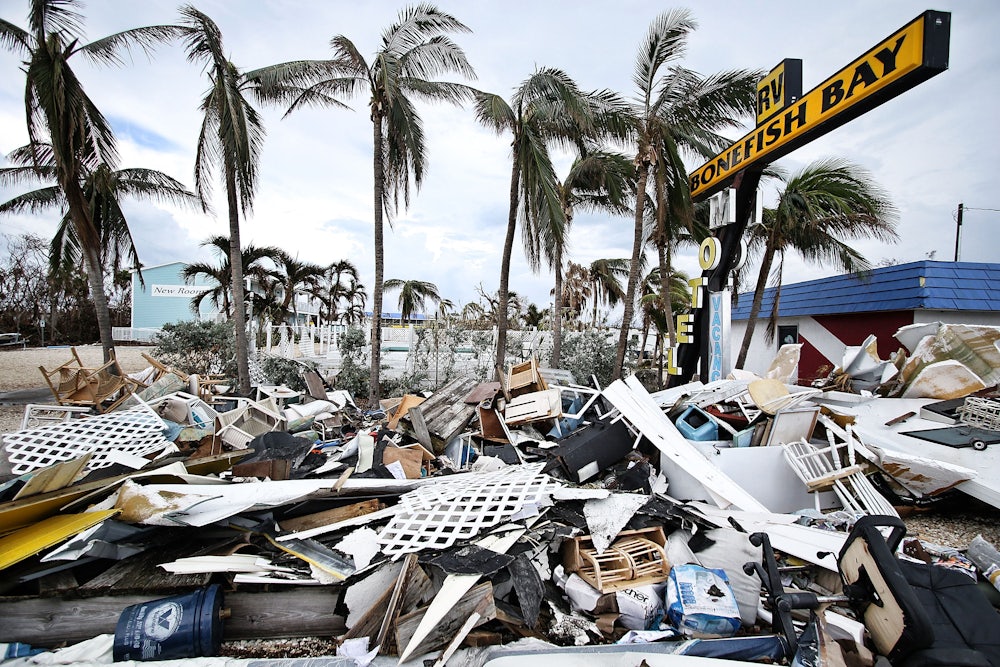On September 4, 2017, Hurricane Irma became the first Category 5 hurricane of the season, with sustained winds of 180 miles per hour at its peak. The storm slammed into Cudjoe Key, Florida, as a Category 4, on the morning of September 10.
Irma’s full-throated arrival at Lynda and Tom Ciano’s home in central Florida was unexpected. Forecasters predicted the storm would hug the state’s west coast. But it shifted track.
“The radioman said, ‘Arcadia, you’re going to get hit hard,’” Tom Ciano recalled. Arcadia is a mere 40 miles from the Cianos’ Lake Placid home.
“That was a real shock, when we heard that on the radio, and the darkness made it worse,” said Tom, a retired electronics technician. “The electricity went out. We couldn’t see anything. It’s one thing to go into a cage with a tiger, and it’s another thing to go into a cage with a tiger when it’s dark.” For 10 hours, they heard objects pummeling the house. “It sounded like it was being destroyed.”
The Cianos’ home remained standing, but their neighborhood was transformed, as was their outlook on life. “I was afraid of the hurricane before it hit. I’m really afraid of hurricanes now,” said Tom.
After the storm, cell phone service was nonexistent. Gasoline to power emergency generators was nowhere to be found. The Cianos said what felt most isolating wasn’t the lack of resources on its own but the helplessness of authorities and neighbors alike. “There’s no one to help you because everybody needs help,” said Lynda, 64, a retired entrepreneur.
Lynda has been disabled since 2013 and recently underwent treatment for breast cancer. For her, that magnified the experience of the storm. “When you’re disabled, you feel helpless. During [Hurricane] Charlie, I was taking care of people.”
Tom, who cares for Lynda, felt a deep sense of responsibility as he prepared for Irma’s arrival. And the experience entirely changed his emotional response to weather reports. It used to be that there was “a little excitement” when storms were headed his way. “Now there is terror. Just the hint of something coming here terrorizes you.”
The couple now feels overwhelming empathy for others hit by natural disasters. Hurricane Maria, which devastated Puerto Rico just a few weeks after Irma left Florida, shook the Cianos. “We see that, and we sit here crying for them,” says Tom. “I can’t begin to understand what it must have been like.” Overall, they feel lucky. “When I think about those people in the fires in California, and what we went through, what do we have to complain about?” asks Tom.
But given the increasing threat of storms in the Southeast, the Cianos say they are planning to move to Arizona, Tom’s home state.
“We definitely wouldn’t have to be afraid of hurricanes anymore, flooding, tornadoes, earthquakes, or any of those things,” said Tom. “Fire would be about the worst thing we would have to worry about. It would feel a lot safer, that’s for sure. We have a whole list of reasons to go there, and that’s one of them.”
Both Lynda and Tom think that the earth has hit a “tipping point” when it comes to climate change. They anticipate hurricanes becoming even larger and deadlier, as they’ve seen during their lifetimes.
“You start watching for hurricanes,” said Lynda. “You become hyperaware of changes in the weather.”
“You can’t predict anymore how big these storms are going to be,” said Tom. “There’s nowhere to go because these storms are so big they cover an entire state. Basically, the whole entire state has to be ready. So, there is nowhere to go. That’s a pretty wild thing to think about.”
Tom used to believe that climate change wouldn’t take hold until somewhere around 2075 or 2050 at the earliest. Not anymore. “I think it’s happening now,” he said. “I’m very, very, very scared and concerned. I’m almost glad that we’re near the end of our lives. I really don’t think we’re going to fix this one. I think we’re talking about trying to fix it. I think maybe what we need to talk about is how we’re going to live with it.”
Both Lynda and Tom don’t know what they would tell their grown children if they should ask for their advice. “There’s nowhere to run to,” Tom said.
“You can see that the kids coming up are thinking about these things very seriously,” said Lynda. “We never gave it a second thought when we were their age, but now we’re giving it a second thought because we’re seeing how much worse it’s gotten in 30 years.”

Voices From the Future is a series from the front lines of climate change and extreme weather, in collaboration with the Julie Ann Wrigley Global Futures Laboratory at Arizona State University.
